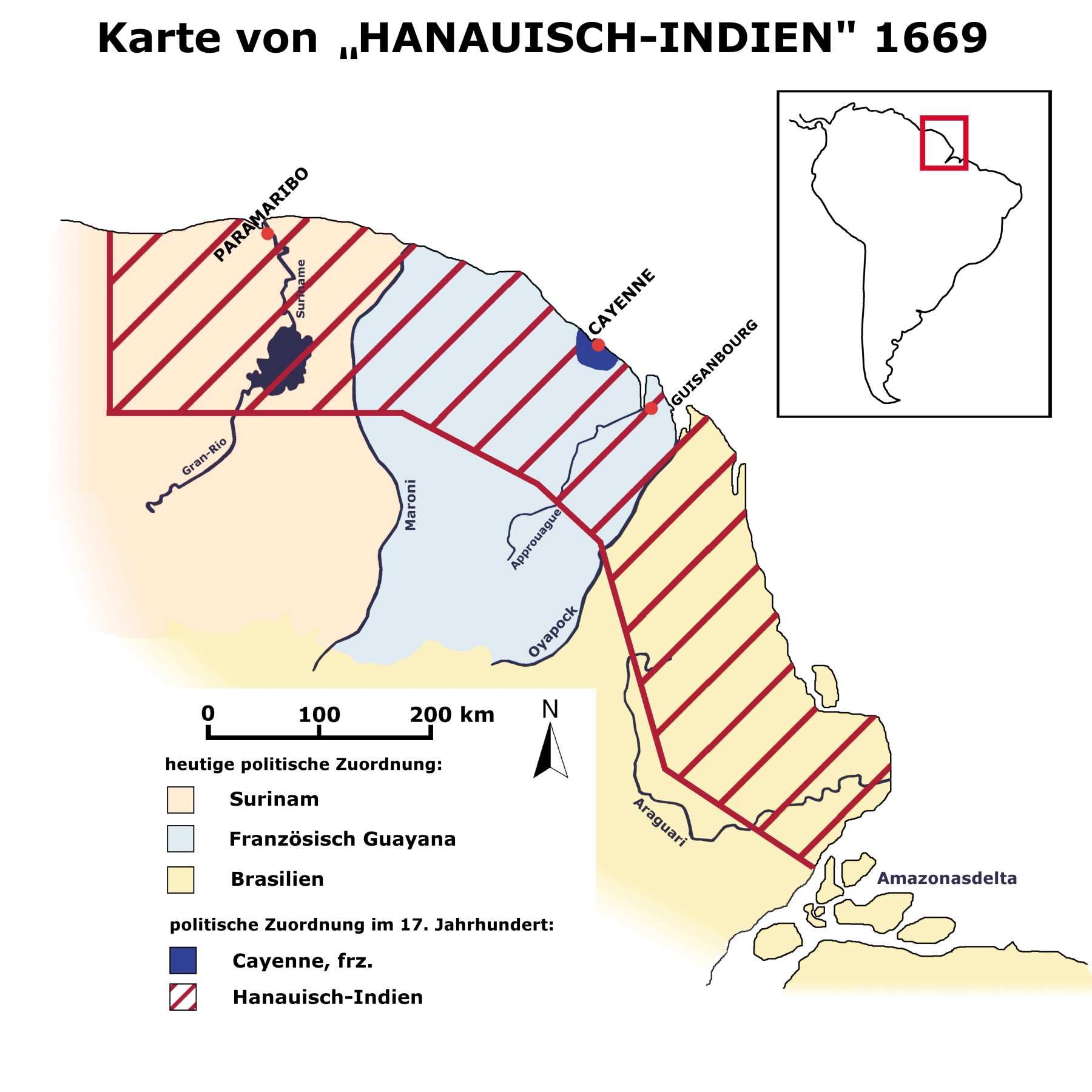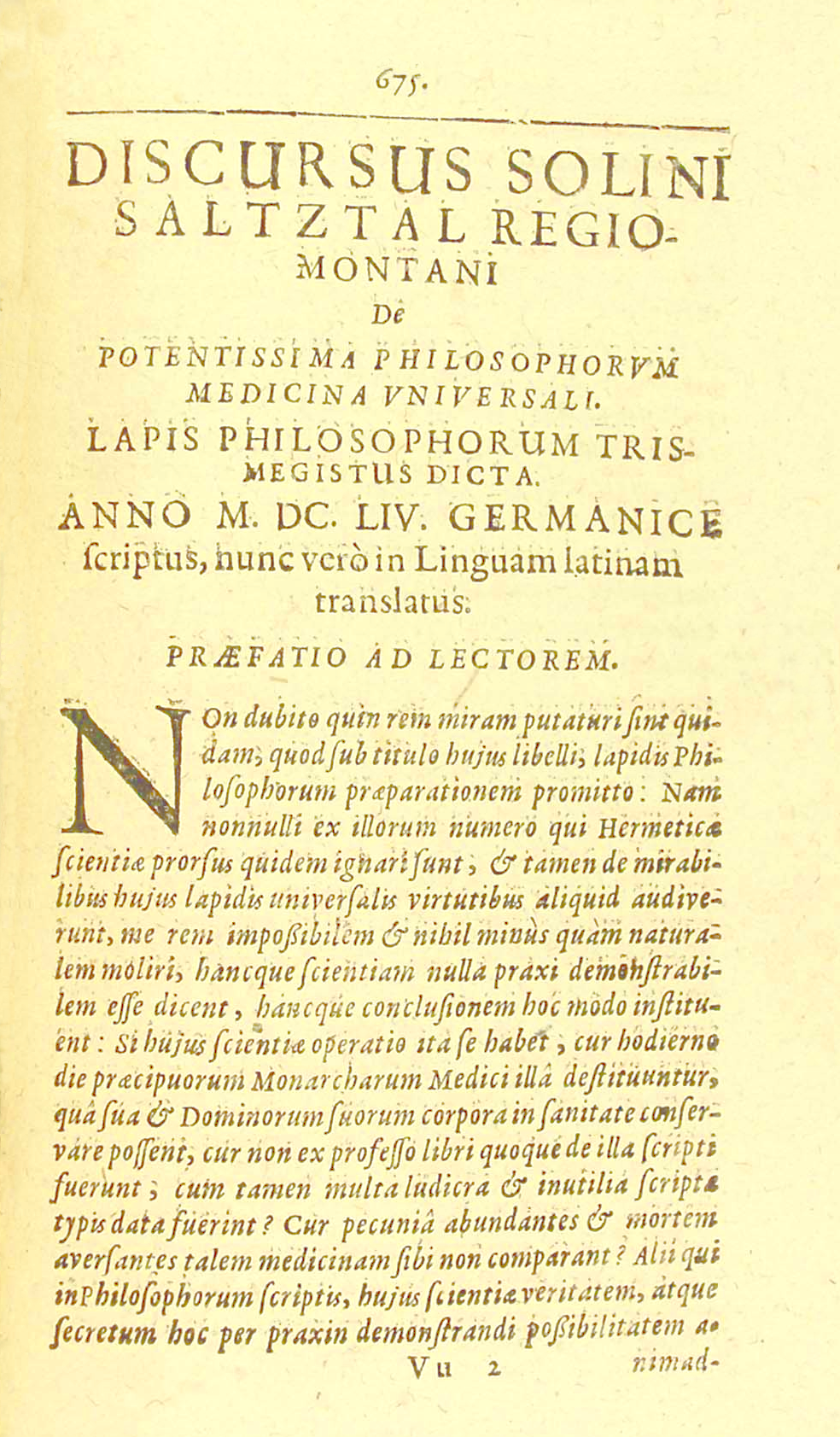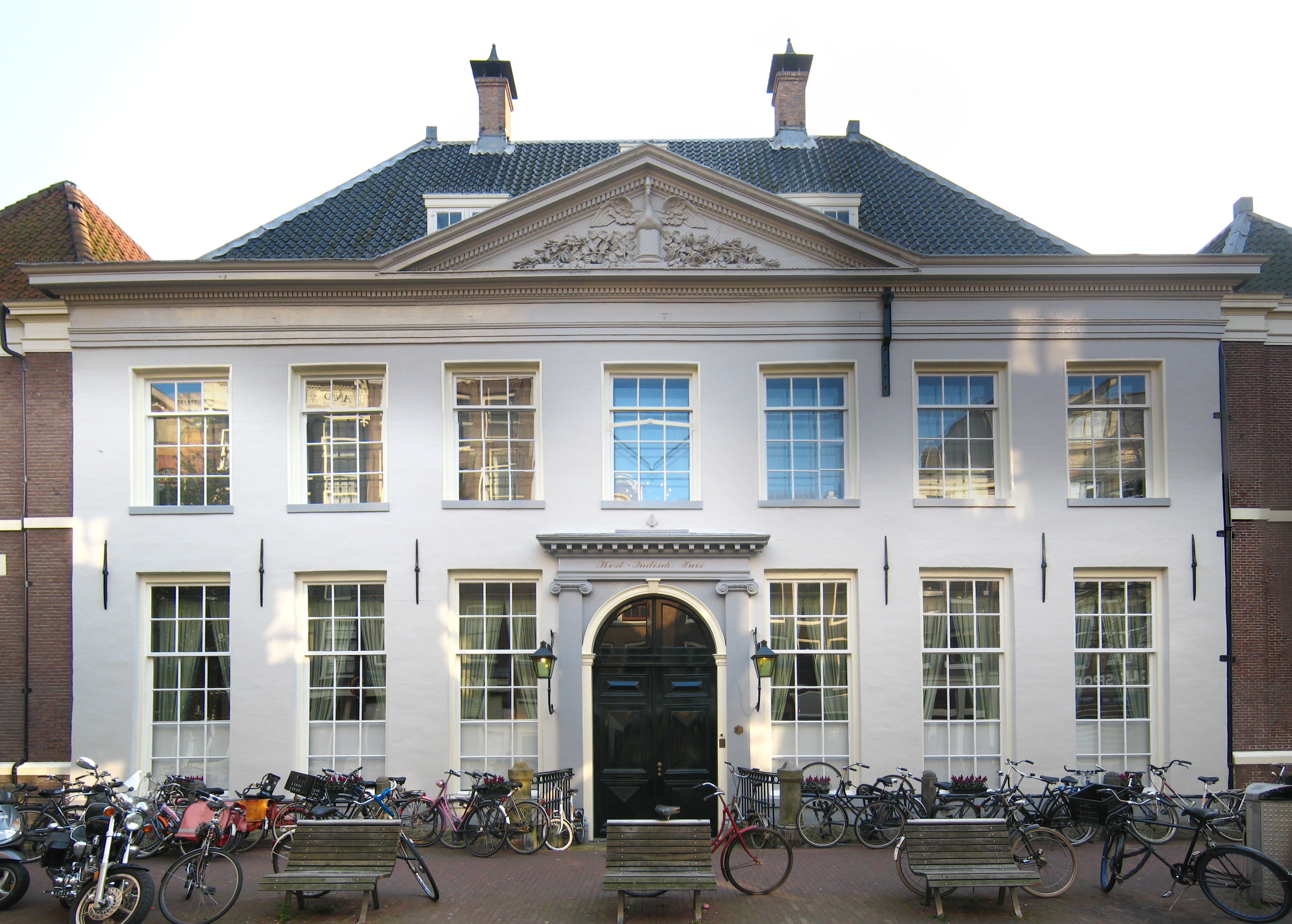|
Hanauish-Indies
The Hanauish Indies (''Hanauisch-Indien ''in German) was the name of a contractually agreed, but never realized, colonial project by the county of Hanau in what is now French Guiana, Suriname and northern Brazil. In July 1669, on behalf of Friedrich Casimir of Hanau in Amsterdam, the Hanau Privy Councilor Johann Joachim Becher signed a contract with the Dutch West India Company to take an area of 3,000 square miles (100,000 km²) from it as a fief. The aim was to achieve a positive trade balance with a colony in order to compensate for the financial problems of the County of Hanau (mercantilism). The plan was to found the ''Kingdom of Hanaui India'' there and to make the Native Indians into a "friendly and civilized" people. The contract provided for extensive rights for the Dutch West India Company, such as a transport monopoly for traffic with the colony. The area of the planned colony was by far larger than the county of Hanau itself which had an area of 44 square mile ... [...More Info...] [...Related Items...] OR: [Wikipedia] [Google] [Baidu] |
County Of Hanau
The County of Hanau was a territory within the Holy Roman Empire, evolved out of the Lordship of Hanau in 1429. From 1456 to 1642 and from 1685 to 1712 it was divided into the County of Hanau-Münzenberg and the County of Hanau-Lichtenberg. After both lines became extinct the ''County of Hanau-Münzenberg'' was inherited by the Landgraviate of Hesse-Kassel, the ''County of Hanau-Lichtenberg'' by the Landgraviate of Hesse-Darmstadt in 1736. Creation In 1429 Emperor Sigismund of the Holy Roman Empire declared Reinhard II. of Hanau a count, so his possessions, the Lordship (''Herrschaft'') of Hanau, became the ''County of Hanau''. The main part of it was positioned to the north of the river Main stretching from the East of Frankfurt am Main eastwards through the valley of the river Kinzig to Schlüchtern and into the Spessart mountains to Partenstein. Legally not correct the title ''County of Hanau'' is used in later literature sometimes also for its territorial predecesso ... [...More Info...] [...Related Items...] OR: [Wikipedia] [Google] [Baidu] |
German Colonization Of The Americas
German attempts at the colonization of the Americas consisted of German Venezuela (german: Klein-Venedig, also german: Welser-Kolonie), Saint Thomas (Brandenburg colony), St. Thomas and Vieques, Puerto Rico, Crab Island in the 16th and 17th centuries. History Klein-Venedig ''Klein-Venedig'' ("Little Venice"; also the etymology of the name "Venezuela") was the most significant part of the German colonization of the Americas, from 1528 to 1546, in which the Augsburg-based Welser banking family to the Habsburgs was given the colonial rights by Emperor Charles V, who was also King of Spain and owed debts to them for his Imperial election, 1519, Imperial election. In 1528, Charles V issued a charter by which the Welsers possessed the rights to explore, rule and colonize the area with the primary motivation of searching for the legendary golden city of El Dorado. The venture was initially led by Ambrosius Ehinger, who founded Maracaibo in 1529. After the deaths of first Ehinger (15 ... [...More Info...] [...Related Items...] OR: [Wikipedia] [Google] [Baidu] |
French Guiana
French Guiana ( or ; french: link=no, Guyane ; gcr, label=French Guianese Creole, Lagwiyann ) is an overseas departments and regions of France, overseas department/region and single territorial collectivity of France on the northern Atlantic Ocean, Atlantic coast of South America in the Guianas. It borders Brazil to the east and south and Suriname to the west. With a land area of , French Guiana is the second-largest Regions of France, region of France (more than one-seventh the size of Metropolitan France) and the largest Special member state territories and the European Union, outermost region within the European Union. It has a very low population density, with only . (Its population is less than that of Metropolitan France.) Half of its 294,436 inhabitants in 2022 lived in the metropolitan area of Cayenne, its Prefectures in France, capital. 98.9% of the land territory of French Guiana is covered by forests, a large part of which is Old-growth forest, primeval Tropical r ... [...More Info...] [...Related Items...] OR: [Wikipedia] [Google] [Baidu] |
Suriname
Suriname (; srn, Sranankondre or ), officially the Republic of Suriname ( nl, Republiek Suriname , srn, Ripolik fu Sranan), is a country on the northeastern Atlantic coast of South America. It is bordered by the Atlantic Ocean to the north, French Guiana to the east, Guyana to the west, and Brazil to the south. At just under , it is the smallest sovereign state in South America. It has a population of approximately , dominated by descendants from the slaves and labourers brought in from Africa and Asia by the Dutch Empire and Republic. Most of the people live by the country's (north) coast, in and around its capital and largest city, Paramaribo. It is also List of countries and dependencies by population density, one of the least densely populated countries on Earth. Situated slightly north of the equator, Suriname is a tropical country dominated by rainforests. Its extensive tree cover is vital to the country's efforts to Climate change in Suriname, mitigate climate ch ... [...More Info...] [...Related Items...] OR: [Wikipedia] [Google] [Baidu] |
Brazil
Brazil ( pt, Brasil; ), officially the Federative Republic of Brazil (Portuguese: ), is the largest country in both South America and Latin America. At and with over 217 million people, Brazil is the world's fifth-largest country by area and the seventh most populous. Its capital is Brasília, and its most populous city is São Paulo. The federation is composed of the union of the 26 States of Brazil, states and the Federal District (Brazil), Federal District. It is the largest country to have Portuguese language, Portuguese as an List of territorial entities where Portuguese is an official language, official language and the only one in the Americas; one of the most Multiculturalism, multicultural and ethnically diverse nations, due to over a century of mass Immigration to Brazil, immigration from around the world; and the most populous Catholic Church by country, Roman Catholic-majority country. Bounded by the Atlantic Ocean on the east, Brazil has a Coastline of Brazi ... [...More Info...] [...Related Items...] OR: [Wikipedia] [Google] [Baidu] |
Friedrich Casimir, Count Of Hanau-Lichtenberg
Friedrich Casimir of Hanau (born 4 August 1623 in Bouxwiller; died 30 March 1685 in Hanau) was a member of the Hanau-Lichtenberg branch of the House of Hanau. He was the ruling Count of Hanau-Lichtenberg from 1641 and of Hanau-Münzenberg from 1642. Childhood and youth Friedrich Casimir was born in Bouxwiller (german: Buchsweiler), the residence of the county of Hanau-Lichtenberg, as the son of Count Philipp Wolfgang (1595–1641) and his wife, Countess Johanna of Oettingen-Oettingen (1602–1639). During his childhood, his parents and he had to flee to Strasbourg several times, due to the Thirty Years' War. On 14 February 1641, Friedrich Casimir succeeded his father as ruler of the county of Hanau-Lichtenberg. Legally, he was still a minor at the time, so that a guardianship had to be set up. Just one year later, in 1642, he also inherited the County of Hanau-Münzenberg. For the first time since 1458 all parts of Hanau were again united in one hand. From 1643 to 1645 ... [...More Info...] [...Related Items...] OR: [Wikipedia] [Google] [Baidu] |
Amsterdam
Amsterdam ( , , , lit. ''The Dam on the River Amstel'') is the Capital of the Netherlands, capital and Municipalities of the Netherlands, most populous city of the Netherlands, with The Hague being the seat of government. It has a population of 907,976 within the city proper, 1,558,755 in the City Region of Amsterdam, urban area and 2,480,394 in the Amsterdam metropolitan area, metropolitan area. Located in the Provinces of the Netherlands, Dutch province of North Holland, Amsterdam is colloquially referred to as the "Venice of the North", for its large number of canals, now designated a World Heritage Site, UNESCO World Heritage Site. Amsterdam was founded at the mouth of the Amstel River that was dammed to control flooding; the city's name derives from the Amstel dam. Originally a small fishing village in the late 12th century, Amsterdam became a major world port during the Dutch Golden Age of the 17th century, when the Netherlands was an economic powerhouse. Amsterdam is th ... [...More Info...] [...Related Items...] OR: [Wikipedia] [Google] [Baidu] |
Geheimrat
''Geheimrat'' was the title of the highest advising officials at the Imperial, royal or princely courts of the Holy Roman Empire, who jointly formed the ''Geheimer Rat'' reporting to the ruler. The term remained in use during subsequent monarchic reigns in German-speaking areas of Europe until the end of the First World War. At its origin the literal meaning of the word in German was 'trusted advisor' - the word "geheim" (secret) implying that such an advisor could be trusted with the Monarch's secrets (similar to "secretary" in English being linguistically related to "secret"). The English-language equivalent is Privy Councillor. The office contributing to the state's politics and legislation had its roots in the age of absolutism from the 17th century onward, when a governmental administration by a dependent bureaucracy was established similar to the French '' Conseil du Roi''. A precursor was the '' Reichshofrat'', a judicial body established by Emperor Maximilian I of Habsbu ... [...More Info...] [...Related Items...] OR: [Wikipedia] [Google] [Baidu] |
Johann Joachim Becher
Johann Joachim Becher (; 6 May 1635 – October 1682) was a German physician, alchemist, precursor of chemistry, scholar and adventurer, best known for his development of the phlogiston theory of combustion, and his advancement of Austrian cameralism. Early life and education Becher was born in Speyer during the Thirty Years War. His father was a Lutheran minister and died when Becher was a child. At the age of thirteen Becher found himself responsible not only for his own support but also for that of his mother and two brothers. He learned and practiced several small handicrafts, devoted his nights to study of the most miscellaneous description and earned a pittance by teaching. In 1654, at the age of nineteen, he published the ''Discurs von der Großmächtigen Philosophischen Universal-Artzney / von den Philosophis genannt Lapis Philosophorum Trismegistus'' (discourse about the almighty philosophical and universal medicine by the philosopher called Lapis Philosophorum Trisme ... [...More Info...] [...Related Items...] OR: [Wikipedia] [Google] [Baidu] |
Dutch West India Company
The Dutch West India Company ( nl, Geoctrooieerde Westindische Compagnie, ''WIC'' or ''GWC''; ; en, Chartered West India Company) was a chartered company of Dutch merchants as well as foreign investors. Among its founders was Willem Usselincx (1567–1647) and Jessé de Forest (1576–1624). On 3 June 1621, it was granted a charter for a trade monopoly in the Dutch West Indies by the Republic of the Seven United Netherlands and given jurisdiction over Dutch participation in the Atlantic slave trade, Brazil, the Caribbean, and North America. The area where the company could operate consisted of West Africa (between the Tropic of Cancer and the Cape of Good Hope) and the Americas, which included the Pacific Ocean and the eastern part of New Guinea. The intended purpose of the charter was to eliminate competition, particularly Spanish or Portuguese, between the various trading posts established by the merchants. The company became instrumental in the largely ephemeral Dutch coloni ... [...More Info...] [...Related Items...] OR: [Wikipedia] [Google] [Baidu] |
Fief
A fief (; la, feudum) was a central element in medieval contracts based on feudal law. It consisted of a form of property holding or other rights granted by an Lord, overlord to a vassal, who held it in fealty or "in fee" in return for a form of feudal allegiance, services and/or payments. The fees were often lands, land revenue or revenue, revenue-producing real property like a watermill, held in feudal land tenure: these are typically known as fiefs or fiefdoms. However, not only land but anything of value could be held in fee, including governmental office, rights of exploitation such as hunting, fishing or felling trees, monopolies in trade, money rents and tax farms. There never did exist one feudal system, nor did there exist one type of fief. Over the ages, depending on the region, there was a broad variety of customs using the same basic legal principles in many variations. Terminology In ancient Rome, a "benefice" (from the Latin noun , meaning "benefit") was a gif ... [...More Info...] [...Related Items...] OR: [Wikipedia] [Google] [Baidu] |

.jpg)


